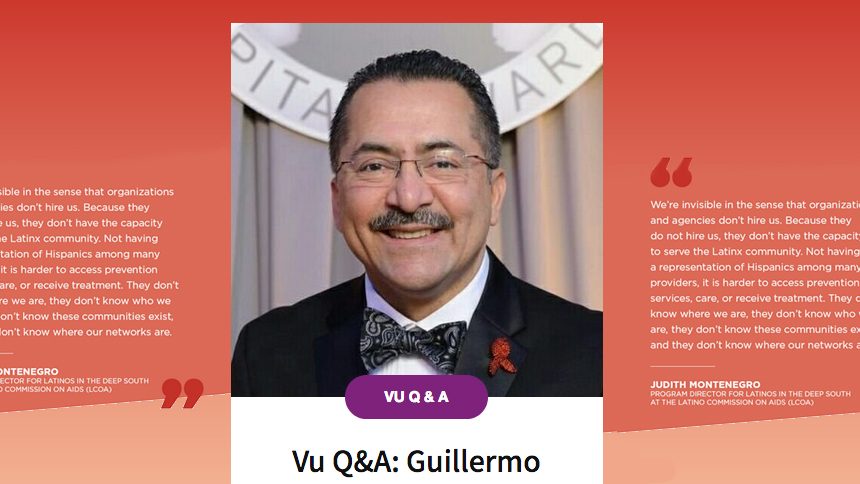Guillermo Chacón is the President of the Latino Commission on AIDS (the Commission). He also founded the Hispanic Health Network and played a key role in the creation of National Latino AIDS Awareness Day (NLAAD)
Q: You have been with the Latino Commission on AIDS for more than 24 years. What motivated you to get involved in the health equity of Hispanic/Latinx people, specifically regarding HIV?
When I joined the Commission back in 1995, it was a very different moment in terms of dealing with HIV and AIDS. I was hired by Dennis De Leon, a leader in our community and the second president of the Latino Commission on AIDS. I knew Dennis from when he worked as the Human Rights Commissioner for David Dinkins, the first African American mayor of New York City. When Dennis left the administration and took over at the Commission, we met and immediately he said, “I need an organizer. I need a community developer and I know you will do an amazing job here.” It was then that I joined the Commission.
As one of my first tasks was to develop community engagement initiatives. These community engagement initiatives became three strategies: building relationships with Latinx faith-based communities, implementing statewide trainings, and increasing strategic engagement with Hispanic media. When we, unfortunately, lost Dennis in December 2009, the board asked me to take over as a president of the Commission.
Whenever someone asks me how I have lasted so long in this organization, I always emphasize the impact this organization has on the Latinx community. Every day I can make a difference, and we now have the tools to prevent the spread of HIV and AIDS. I think that has been my motivation since day one.
Q: In 2017, there were more than 38,000 new HIV diagnoses in the U.S. and Puerto Rico. While the annual number of new HIV diagnoses has declined overall, certain populations continue to be disproportionately impacted by HIV, including the Black and Hispanic/Latinx communities. In your opinion, what is driving the disproportionate impact of HIV on Hispanics/Latinx?
I think the most difficult thing is that the Hispanic/Latinx community is an invisible community to a broader audience. There is often a disproportionate risk of infection within the Latinx community, especially among Young Gay and Bisexual Men. Additionally, the health and human service sectors of both the federal government and local jurisdictions, and physicians in many communities don’t understand how complex and diverse the Hispanic/Latinx community is.
When looking at the continental U.S. in the past couple of censuses, the largest population increase was among minorities. If you specifically look at regions like the Southern U.S., you can see the Latinx community increase in size over the last 20 years. However, I still think the clinical providers, case managers, and health navigators are disproportionately not Hispanic or Latinx, so, therefore, don’t understand who we are. The past 20 years of migration patterns and economic opportunities have created an emerging Latinx community in the South. Despite this trend, Latinx people continue to be underrepresented in important public health services, particularly in terms of HIV prevention. Throughout the South and in the Midwest, there are many pockets of Hispanic/Latinx communities that I believe we need to do a better job engaging.
The final piece is the current situation in Puerto Rico, which is of serious concern and requires urgent attention. The devastating hurricanes Irma and Maria had a significant impact on HIV outcomes among people already living with HIV or facing other structural barriers to access care, prevention services and treatment for HIV.
Q: In 2016, 43% of all new HIV diagnoses among Hispanics/Latinx occurred in the Southern United States. What needs to be done to address HIV among Hispanic/Latinx communities in the South?
I think stigma is a key problem. Stigma associated with HIV is very persistent nationally but, in the South, it is more complex and is a major issue that we need to address. One way to do this is through community building. Organizations like the Commission work in the South to partner with state health departments to build collaboration among organizations and institutions providing HIV services while also addressing specific issues related to homophobia, transphobia, and xenophobia (fear of immigrants). The social tensions that we have right now overall, especially in the South, are very disturbing.
There is also the challenge of the changing demographics within the Latinx community, which is especially prominent in the Southern states. Florida, for example, has had a highly concentrated Latinx population for the past 15 years. But now we are seeing a trend in the changing Hispanic population across the South. The population that traditionally was a majority-Cuban is now way more diverse because of the increased immigration from South and Central American countries. Our next challenge will be to go more in-depth with community mapping and focus on engaging with health care providers.
Hosting community events or gatherings have also been a major focus for the Commission. We were able to produce a regional Hispanic/Latinx meeting in Georgia this past July. The people who attended were able to garner visibility for their region for the first time. This allows these community leaders to begin to collaborate among themselves and with partners like the Coalition, or initiatives like COMPASS, that are trying to empower community-based organizations working to combat the HIV and AIDS epidemic in the South – which is something that we truly believe is crucial.
Q: The Latino Commission on AIDS plays a critical role in addressing and helping to prevent HIV/AIDS and other sexually transmitted infections. As part of this, how did National Latino AIDS Awareness Day (NLAAD) begin? How has it been successful in recent years?
I think a lot of people don’t know that National Latinx AIDS Awareness Day (NLAAD) began with the Latino Commission on AIDS. Since day one, we have tried to be clear that NLAAD is an important community mobilization and social messaging campaign that aims to bring Hispanic/Latinx communities together. This awareness day allows us to partner with many organizations, and use social media and marketing to mobilize the community, allowing for full ownership at the local level. We encourage people to craft and develop their own messaging and tailor it to their individual communities. Throughout the last few years, we have made it a goal to adopt more platforms and help foster a diverse network of Hispanic and Latinx communities. For example, on the eve of NLAAD, we always see a large number of people that engage and commit themselves to organize local groups. I am always very excited when people ask us about organizing materials such as campaign kits and posters.
This year’s campaign theme is “Living with HIV or Not, We Are Fighting This Together.” This campaign aims at uniting local, regional, and national partners to help break the stigma and show we all have a responsibility to help end the epidemic. This campaign goes hand-in-hand with some key developments. We know today that people living with HIV who are on treatment and have an undetectable viral load cannot sexually transmit HIV. This is known as ‘Undetectable equals Untransmittable,’ or ‘U=U.’ HIV stigma has destroyed so many lives and impeded our progress in ending new transmissions, particularly within Latinx communities. The other important issue is the federal Ending the HIV Epidemic: A Plan for America initiative. We strongly believe that NLAAD acts as a platform for ending the epidemic work because we maintain a large and well-informed network of local partners who are willing to engage with and embrace this important initiative.
This October 15, we are also going to be emphasizing the need for our entire network to help us craft a National Hispanic Latinx Health Leadership Agenda. This will all culminate in a summit in Washington, D.C. in early 2020, where we will activate our network of communities that we have been building since 2003. The Agenda will link the commitment of raising awareness with the commitment to be proactive, and work to impact not only HIV but also viral hepatitis, sexually transmitted infections, and also all of the health issues that impact our community as a whole.
Q: In honor of National Latino AIDS Awareness Day coming up on Tuesday, October 15, what is your message to the Latinx community?
This is the best time for us to rally and unite our voices and actions. We must address the challenge of the increase in new HIV infections among our communities, and learn from other communities to develop partnerships with non-traditional institutions in order to elevate their voices, make sure communities who are more impacted by HIV are seen, and emphasize the different challenges the Southern U.S. and the island of Puerto Rico face when it comes to fighting the HIV epidemic.
I truly believe that this coming October 15 is also going to be a moment to pause and remember all those people that we lost. In their memory, we need to do a better job to increase awareness of HIV testing, prevention, and treatment options. We need to emphasize the importance of antiretroviral medications because we know those who take their medicine as prescribed maintain an undetectable viral load and emphasis that U=U for all people living with HIV. This allows those with HIV to live long and healthy lives and is one of the most important vehicles to reduce and erase stigma.
Source: This article has been copied from www.aidsvu.org


